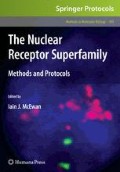Abstract
RNA interference can be extremely useful in determining the function of an endogenously-expressed protein in its normal cellular environment. In this chapter, we describe a method that uses small interfering RNA (siRNA) to knock down mRNA and protein expression in cultured cells so that the effect of a putative regulatory protein on gene expression can be delineated. Methods of assessing the effectiveness of the siRNA procedure using real time quantitative PCR and Western analysis are also included.
Access this chapter
Tax calculation will be finalised at checkout
Purchases are for personal use only
References
Harborth, J., Elbashir, S. M., Bechert, K., Tuschl, T., and Weber, K. (2001) Identification of essential genes in cultured mammalian cells using small interfering RNAs. J Cell Sci 114, 4557–65.
Harborth, J., Elbashir, S. M., Vanden-burgh, K., Manninga, H., Scaringe, S. A., Weber, K., and Tuschl, T. (2003) Sequence, chemical, and structural variation of small interfering RNAs and short hairpin RNAs and the effect on mammalian gene silencing. Antisense Nucleic Acid Drug Dev 13, 83–105.
Fire, A., Xu, S., Montgomery, M. K., Kostas, S. A., Driver, S. E., and Mello, C. C. (1998) Potent and specific genetic interference by double-stranded RNA in Caenorhabditis ele-gans. Nature 391, 806–11.
Montgomery, M. K., and Fire, A. (1998) Double-stranded RNA as a mediator in sequence-specific genetic silencing and co-suppression. Trends Genet 14, 255–8.
Tuschl, T., Zamore, P. D., Lehmann, R., Bar-tel, D. P., and Sharp, P. A. (1999) Targeted mRNA degradation by double-stranded RNA in vitro. Genes Dev 13, 3191–7.
Bernstein, E., Caudy, A. A., Hammond, S. M., and Hannon, G. J. (2001) Role for a biden-tate ribonuclease in the initiation step of RNA interference. Nature 409, 363–6.
Elbashir, S. M., Harborth, J., Lendeckel, W., Yalcin, A., Weber, K., and Tuschl, T. (2001) Duplexes of 21-nucleotide RNAs mediate RNA interference in cultured mammalian cells. Nature 411, 494–8.
Elbashir, S. M., Lendeckel, W., and Tuschl, T. (2001) RNA interference is mediated by 21- and 22-nucleotide RNAs. Genes Dev 15, 188–200.
Jackson, A. L., Bartz, S. R., Schelter, J., Koba-yashi, S. V., Burchard, J., Mao, M., Li, B., Cavet, G., and Linsley, P. S. (2003) Expression profiling reveals off-target gene regulation by RNAi. Nat Biotechnol 21, 635–7.
Schwarz, D. S., Tomari, Y., and Zamore, P. D. (2004) The RNA-induced silencing complex is a Mg2 ; -dependent endonuclease. Curr Biol 14, 787–91.
Curtis, C. D., Likhite, V. S., McLeod, I. X., Yates, J. R., and Nardulli, A. M. (2007) Interaction of nonmetastatic protein 23 homolog H1 and estrogen receptor alpha alters estrogen-responsive gene expression and DNA nicking. Cancer Res 67, 10600–7.
Marzouk, S., Schultz-Norton, J., McLeod, I., Yates, J., and Nardulli, A. (2007) Rho GDP dissociation inhibitor alpha interacts with estrogen receptor alpha and influences estrogen responsiveness. J Mol Endocrinol 39, 249–59.
Rao, A. K., Ziegler, Y. S., McLeod, I. S., Yates, J. R., and Nardulli, A. M. (2008) Effects of Cu/Zn Superoxide Dismutase (SOD1) on estrogen responsiveness and oxidative stress in human breast cancer cells. Mol Endocrinol 22, 1113–1124.
Schultz-Norton, J. R., McDonald, W. H., Yates, J. R., and Nardulli, A. M. (2006) Protein disulfide isomerase serves as a molecular chap-erone to maintain estrogen receptor α structure and function. Mol Endocrinol 20, 1982–95.
Schultz-Norton, J. R., Walt, K. A., Ziegler, Y. S., McLeod, I. X., Yates, J. R., Raetz-man, L. T., and Nardulli, A. M. (2007) The DNA repair protein flap endonucle-ase-1 (FEN-1) modulates estrogen-responsive gene expression. Mol Endocrinol 21, 1569–80.
Schultz-Norton, J. R., Gabisi, V. A., Ziegler, Y. S., McLeod, I. X., Yates, J. R., and Nardulli, A. M. (2007) Estrogen receptor alpha interaction with the DNA repair protein proliferating cell nuclear antigen (PCNA). Nucleic Acids Res 35, 5028–38.
Brummelkamp, T. R., Bernards, R., and Agami, R. (2002) Stable suppression of tum-origenicity by virus-mediated RNA interference. Cancer Cell 2, 243–7.
Brummelkamp, T. R., Bernards, R., and Agami, R. (2002) A system for stable expression of short interfering RNAs in mammalian cells. Science 296, 550–3.
Paddison, P. J., Caudy, A. A., Bernstein, E., Hannon, G. J., and Conklin, D. S. (2002) Short hairpin RNAs (shRNAs) induce sequence-specific silencing in mammalian cells. Genes Dev 16, 948–58.
Acknowledgments
We are grateful to J. Bonéy Montoya, A. Rao, D. Thorngren, and Y. Ziegler for assistance in the preparation of this manuscript. This work was supported by NIH grant R01 DK 53884 (to AMN).
Author information
Authors and Affiliations
Editor information
Editors and Affiliations
Rights and permissions
Copyright information
© 2009 Humana Press, a part of Springer Science+Business Media, LLC
About this protocol
Cite this protocol
Curtis, C.D., Nardulli, A.M. (2009). Using RNA Interference to Study Protein Function. In: McEwan, I.J. (eds) The Nuclear Receptor Superfamily. Methods in Molecular Biology™, vol 505. Humana Press. https://doi.org/10.1007/978-1-60327-575-0_11
Download citation
DOI: https://doi.org/10.1007/978-1-60327-575-0_11
Publisher Name: Humana Press
Print ISBN: 978-1-60327-574-3
Online ISBN: 978-1-60327-575-0
eBook Packages: Springer Protocols

